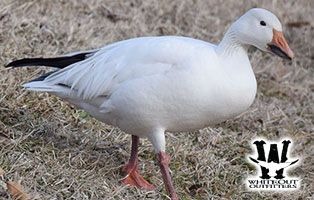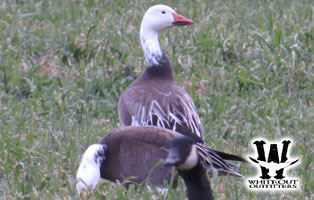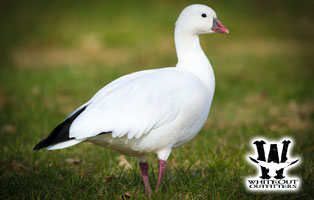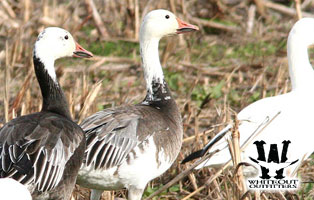Snow Goose Image Identification
Identification and Snow Geese
Snow Goose

Blue Goose

Ross's Goose

Hybrid Blue Goose

Snow Goose Facts
Learn More About Snow Geese
Snow geese are remarkable creatures that grace our skies with their presence during their annual migrations. These elegant birds are known for their striking white plumage, but there's so much more to discover about them. In this article, we'll delve into the world of snow geese and uncover some amazing facts that will leave you in awe of these incredible birds.
1. Appearance and Plumage:
One of the most distinctive features of snow geese is their snow-white plumage, which gives them their name. However, they are not entirely white; they often have black wingtips, which are visible during flight. Juvenile snow geese, on the other hand, have a more subdued grayish appearance, gradually developing their characteristic white feathers as they mature.
2. Species Diversity:
Snow geese are divided into two main species: the Greater Snow Goose and the Lesser Snow Goose. The Greater Snow Goose is larger and has a longer neck than its counterpart. These two species are further divided into several subspecies based on their breeding and migratory ranges.
3. Incredible Migration:
Snow geese are famous for their long-distance migrations. They breed in the Arctic and subarctic regions of North America and then embark on an epic journey southward for the winter. Their migration can cover thousands of miles, taking them from their breeding grounds to their wintering areas along the Gulf of Mexico and even as far south as Mexico.
4. Impressive Numbers:
Snow geese are known for their large flocks, which can number in the hundreds of thousands or even millions during migration. Their collective flight formations, known as "v-formations," are a spectacular sight to behold in the sky.
5. Vocal Communication:
Snow geese are not just visually striking; they are also known for their distinctive vocalizations. Their calls can range from soft clucks to loud, honking sounds. These vocalizations play a crucial role in maintaining communication within the flock.
6. Herbivorous Diet:
Snow geese are primarily herbivores, feeding on a diet of grasses, sedges, and other vegetation. During migration, they often forage in agricultural fields, making them a significant concern for farmers due to their crop-damaging activities.
7. Conservation Efforts:
While snow geese are not currently considered endangered, their populations have fluctuated over the years. Conservation efforts are in place to monitor and protect these magnificent birds and their habitats. These include regulating hunting seasons and protecting critical breeding and wintering areas.
Snow geese are truly remarkable creatures, known for their stunning appearance, impressive migrations, and vital role in the ecosystems they inhabit. Learning about these facts not only deepens our appreciation for the natural world but also highlights the importance of conserving their habitats to ensure their continued presence in our skies for generations to come.
